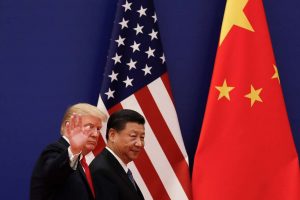AUGUST 18, 2018
 U.S. President Donald Trump waves next to Chinese President Xi Jinping after attending a business event at the Great Hall of the People in Beijing, Thursday, Nov. 9, 2017. – AP Photo/Andy Wong
U.S. President Donald Trump waves next to Chinese President Xi Jinping after attending a business event at the Great Hall of the People in Beijing, Thursday, Nov. 9, 2017. – AP Photo/Andy Wong
BRIDGEWATER, N.J. — After 18 months of treating North Korea as the top national security threat, President Trump has increasingly turned his attention to China, taking a more confrontational approach that experts said shows a risky shift in U.S. policy.
From an escalating trade war to that counters Chinese maritime expansion, the Trump administration has taken aim at the East Asian power in a contest of wills that has led to a growing consensus in Beijing that the United States is seeking to contain China’s rise.
Trump’s rhetoric has grown sharper since last year, when he attempted to strike a rapport with his “good friend” President Xi Jinping. Last week, Trump cited the Chinese military as the rationale for creating a new “Space Force” at the Pentagon, and on Saturday he injected China into the specter of foreign influence of U.S. elections.
“All of the fools that are so focused on looking only at Russia should start also looking in another direction, China,” the president wrote, without offering evidence of any Chinese conspiracy.
Analysts said the rise in hostility suggests that Trump and his advisers have come to view the communist nation as a malign power and direct competitor and adversary whose expanding influence must be blunted through more extreme countermeasures. To a degree, it is a view that is shared more widely among Washington foreign policy analysts as Xi has consolidated power and pursued an aggressive agenda of economic growth and territorial expansion.
But analysts said the Trump administration has yet to articulate a clear strategy to deal with China even it signals a sharp departure from the approach of previous administrations. President Barack Obama sought to cooperate with Beijing on major global initiatives, such as the Paris climate accord and the Iran nuclear deal, as a way to manage China’s growth and encourage it to act more responsibly in the international system.
Trump has pulled the United States out of both of those pacts.
“I do not see very many issues this administration is trying to work with China on,” said Bonnie Glaser, a China analyst at the Center for Strategic and International Studies in Washington. “The effort to come up with new things where our interests converge has been abandoned. I think this administration is in agreement that China is a competitor, and the effort here is really focused on how we have a more effective competitive strategy with China.”
Trump’s preoccupation with China was on display at at the White House on Thursday. During the hour-long discussion, open to reporters, the president accused China of easing economic pressure on North Korea and of flooding addictive opioids into the United States.
Economic analysts have criticized Trump for sparking a trade war with China by slapping tariffs on steel and aluminum in the spring. In the meeting, the president appeared eager to prove he was right to impose tariffs and to paint Beijing as the loser, pointedly asking his top economic adviser, Larry Kudlow, to update him on China’s economic growth.
“Their economy is heading south,” Kudlow replied. “I will just say, right now, their economy looks terrible.”
Trump had talked tough on China throughout his campaign, but he pulled back after taking office and inviting Xi to his Mar-a-Lago resort in Florida in the spring of 2017. The president declined to follow through on threats to label China a “currency manipulator” as he sought to enlist Beijing’s help in his international pressure campaign on North Korea.
But the president has soured on Beijing as his bid to force Pyongyang to live up to commitments made with leader Kim Jong Un in a nuclear summit in Singapore has faltered. As Trump’s relationship with Kim has appeared to enter an uneasy detente, analysts suggested the president sees China as a convenient political foil to juice his domestic political base.
There is doubt about whether the strategy is working. Since the spring, the world’s two largest economies have each put tariffs on $34 billion worth of goods, with $16 billion more slated to take effect this week. The trade war has sparked anxiety among some U.S. industries and, in June, forced the Trump administration to announce plans for a $12 billion bailout to farmers affected by retaliatory Chinese tariffs on soy, corn, wheat and other agricultural products.
A Chinese delegation is scheduled to visit Washington for lower-level trade talks.
“The Trump administration is trying surgery with a chain saw in making threats and demanding unconditional surrender,” said Daniel Russel, an analyst at the Asia Society who served as a top Asia policy official in the Obama administration. “The Chinese tell me they see a clear connection between the aggressive push on trade and the language in the National Security Strategy and other documents labeling China, in effect, an enemy.”
That strategy document, released in December, called China a “revisionist power” that seeks to displace U.S. leadership in Asia and expand the reach of its “state-driven” economic model.
For all of Trump’s rhetoric, however, his administration has not sketched out a convincing strategy to blunt China’s expansion, analysts said.
Trump’s withdrawal of the United States from potential membership in the Trans-Pacific Partnership, a 12-nation trade pact viewed by the Obama administration as a bulwark on China, left regional partners uncertain about the administration’s commitment to the region.
Late last month, Secretary of State Mike Pompeo announced an initial investment of $113 million in energy, infrastructure and digital commerce as the economic cornerstone of an “Indo-Pacific” strategy, which was interpreted by Washington’s foreign policy community as a lackluster attempt by Trump’s team to offer an alternative vision. The investment paled in comparison to China’s giant “belt and road” economic program that is distributing tens of billions of dollars in government-backed infrastructure loans across the region.
In an attempt to soothe the concerns of American business leaders, Matt Pottinger, the senior director for Asia at the National Security Council, emphasized at the U.S. Chamber of Commerce that the initial sum was a starting point to jump-start American private sector investments that China can’t match.
“We know there’s anxiety about the adjustment that’s taking place in U.S. bilateral relationships, maybe one in particular,” Pottinger said, referring to China. “That adjustment is overdue. It’s inevitable. What’s important now is for the United States and our partners to look forward to the 21st century competition that all of us are facing and that together we will be able to win.”
Courtesy: Washington Post










































































































